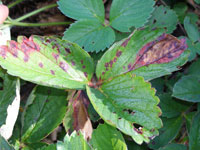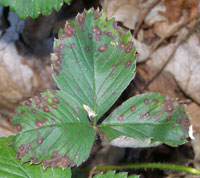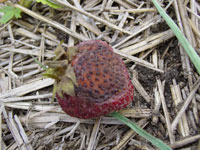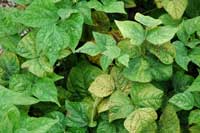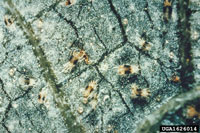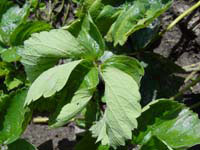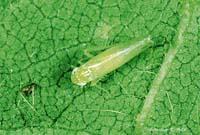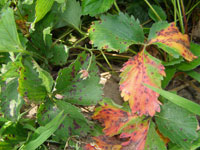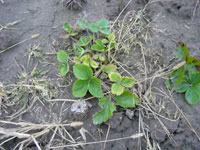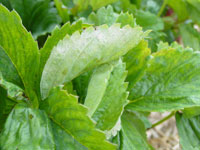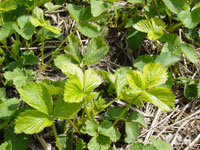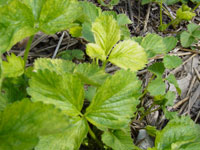Extension > Garden > Diagnose a problem > What's wrong with my plant? > Fruit > Strawberry > Discolored leaves
Strawberries > Leaves > Discolored
1 of 9
Leaf Blight
Phomopsis obscurans
- First see purplish red round leaf spots with a gray brown center
- Spots grow into a large V shaped lesion with a dry brown triangle in the center and a reddish purple V shaped border
- Elongated, sunken, purplish brown or reddish brown spots or streaks may be seen on stems
- Berries can develop soft pink-brown spots
- More information on Leaf Blight
2 of 9
Spider Mites
Tetranychus urticae
- Feeding on the underside of leaves causes a “russet” appearance to the leaves; leaves may become distorted
- In heavy infestations, webbing can be found on underside of leaves
- Adult spider mites are very small (approximately 1/50 inch in length), and are yellow to dark crimson, with dark spots
- Mites usually appear in late June-August; more prevalent in hot, dry weather
- More information on Spider Mites
3 of 9
Potato Leafhopper
Empoasca fabae
- Leaves appear wrinkled from leafhopper feeding; may have a yellow tinge to the leaves
- PLH adults are lime green, slender, small (1/8 inch long), and wedge-shaped
- Leafhoppers are present from June-August
- More information on Potato Leafhopper
4 of 9
Nitrogen Deficiency
- Leaves turn yellow, most obvious on older, lower leaves
- Plants grow slowly, produce few leaves and daughter plants
- Plant produce few and small berries
- Common in sandy soils
- More information on Nitrogen Deficiency
5 of 9
Leaf Scorch
Diplocarpon earlianum
- Small solid purple spots on leaves, No light colored center
- Leaf tissue around spots turn reddish or purple
- Edges of leaves eventually turn brown and dry out; appearing burnt or "scorched"
- Elongated, sunken, purplish brown or reddish brown spots or streaks may be seen on stems
- More information on Leaf Scorch
6 of 9
Glyphosate Herbicide Injury
- Yellowing appears suddenly, and is restricted to the veins
- Plant appears stunted because of small leaves crowded close together
7 of 9
Powdery Mildew
Podosphaera aphanis
- Infected leaflets curl up, exposing undersides that often are reddened and coated with a grayish white powdery mildew fungus
- Leaves will eventually turn purple or red
- Common in mid to late summer
- More information on Powdery Mildew
8 of 9
June Yellows
- Plants turn completely yellow in May and June but then later recover
- Genetic disorder common in Mesabi and related varieties
9 of 9
Iron Chlorosis
- Youngest leaves turn white, leaf veins remain green
- Common in clay soils and soils with high soil pH
- More information on Iron Chlorosis



